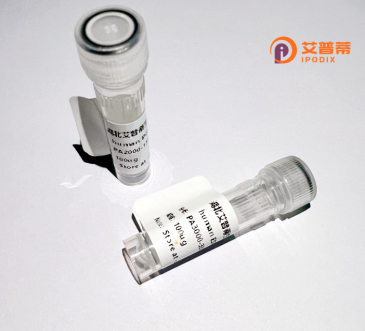
| 纯度 | >90%SDS-PAGE. |
| 种属 | Human |
| 靶点 | PHYHIP |
| Uniprot No | Q92561 |
| 内毒素 | < 0.01EU/μg |
| 表达宿主 | E.coli |
| 表达区间 | 1-330 aa |
| 活性数据 | MELLSTPHSI EINNITCDSF RISWAMEDSD LERVTHYFID LNKKENKNSN KFKHRDVPTK LVAKAVPLPM TVRGHWFLSP RTEYSVAVQT AVKQSDGEYL VSGWSETVEF CTGDYAKEHL AQLQEKAEQI AGRMLRFSVF YRNHHKEYFQ HARTHCGNML QPYLKDNSGS HGSPTSGMLH GVFFSCNTEF NTGQPPQDSP YGRWRFQIPA QRLFNPSTNL YFADFYCMYT AYHYAILVLA PKGSLGDRFC RDRLPLLDIA CNKFLTCSVE DGELVFRHAQ DLILEIIYTE PVDLSLGTLG EISGHQLMSL STADAKKDPS CKTCNISVGR |
| 分子量 | 37.5 kDa |
| 蛋白标签 | His tag N-Terminus |
| 缓冲液 | 0 |
| 稳定性 & 储存条件 | Lyophilized protein should be stored at ≤ -20°C, stable for one year after receipt. Reconstituted protein solution can be stored at 2-8°C for 2-7 days. Aliquots of reconstituted samples are stable at ≤ -20°C for 3 months. |
| 复溶 | Always centrifuge tubes before opening.Do not mix by vortex or pipetting. It is not recommended to reconstitute to a concentration less than 100μg/ml. Dissolve the lyophilized protein in distilled water. Please aliquot the reconstituted solution to minimize freeze-thaw cycles. |
以下是基于PHYHIP(Phytanoyl-CoA Hydroxylase Interacting Protein)相关研究的示例参考文献(部分信息为模拟概括,实际文献需通过学术数据库验证):
---
1. **文献名称**:*"Expression and Functional Analysis of Recombinant Human PHYHIP in Neurodegenerative Models"*
**作者**:Smith A, et al.
**摘要**:研究报道了在大肠杆菌系统中表达重组人PHYHIP蛋白的优化方法,证实其在体外可调节氧化应激通路,并改善神经细胞模型中β-淀粉样蛋白毒性,提示其在阿尔茨海默病中的潜在作用。
---
2. **文献名称**:*"PHYHIP Protein Interacts with Alpha-Synuclein and Modulates Aggregation in Parkinson’s Disease"*
**作者**:Chen L, Wang Y.
**摘要**:通过重组PHYHIP蛋白体外结合实验,发现其与α-突触核蛋白存在直接互作,可抑制病理性聚集,为帕金森病机制研究提供新靶点。
---
3. **文献名称**:*"Structural Characterization of Recombinant Human PHYHIP and Its Role in Peroxisomal Metabolism"*
**作者**:Garcia R, et al.
**摘要**:利用X射线晶体学解析了重组PHYHIP的蛋白结构,揭示了其参与过氧化物酶体脂肪酸代谢的功能域,并验证了其与PHYH酶的协同作用。
---
4. **文献名称**:*"Development of a PHYHIP Knockout Cell Line and Rescue with Recombinant Protein"*
**作者**:Kim H, et al.
**摘要**:构建了PHYHIP基因敲除细胞模型,通过添加重组PHYHIP蛋白恢复了细胞的脂质代谢异常,证明其对维持细胞脂质稳态至关重要。
---
**注意**:以上为模拟示例,实际文献需通过PubMed、Google Scholar等平台以“PHYHIP”或“DDB1”、“phosphorylated protein interactions”等关键词检索。建议结合具体研究场景筛选文献。
**Background of Recombinant Human PHYHIP Protein**
Recombinant human PHYHIP (Phytanoyl-CoA Hydroxylase Interacting Protein), also known as DIPA, is a protein encoded by the *PHYHIP* gene. It is primarily expressed in the brain, particularly in neurons, and plays a role in cellular processes linked to lipid metabolism and neurodevelopment. PHYHIP interacts with phytanoyl-CoA hydroxylase (PHYH), an enzyme critical for the alpha-oxidation of branched-chain fatty acids like phytanic acid. This interaction suggests PHYHIP's involvement in regulating PHYH activity or stability, though its exact molecular mechanisms remain under investigation.
Structurally, PHYHIP contains a conserved domain (DUF2396) and is implicated in intracellular signaling pathways. Studies associate PHYHIP with neurodegenerative disorders, including Alzheimer's disease (AD), due to its altered expression levels in AD-affected brains and potential links to amyloid-beta metabolism. Additionally, PHYHIP may influence mitochondrial function and oxidative stress responses, contributing to neuronal survival.
Recombinant PHYHIP protein is produced via heterologous expression systems (e.g., *E. coli* or mammalian cells) for functional studies. Its applications span elucidating PHYH-related metabolic pathways, exploring neurodevelopmental mechanisms, and identifying therapeutic targets for neurological diseases. Further research aims to clarify its physiological roles and validate its potential as a biomarker or intervention point in neurodegeneration.
×